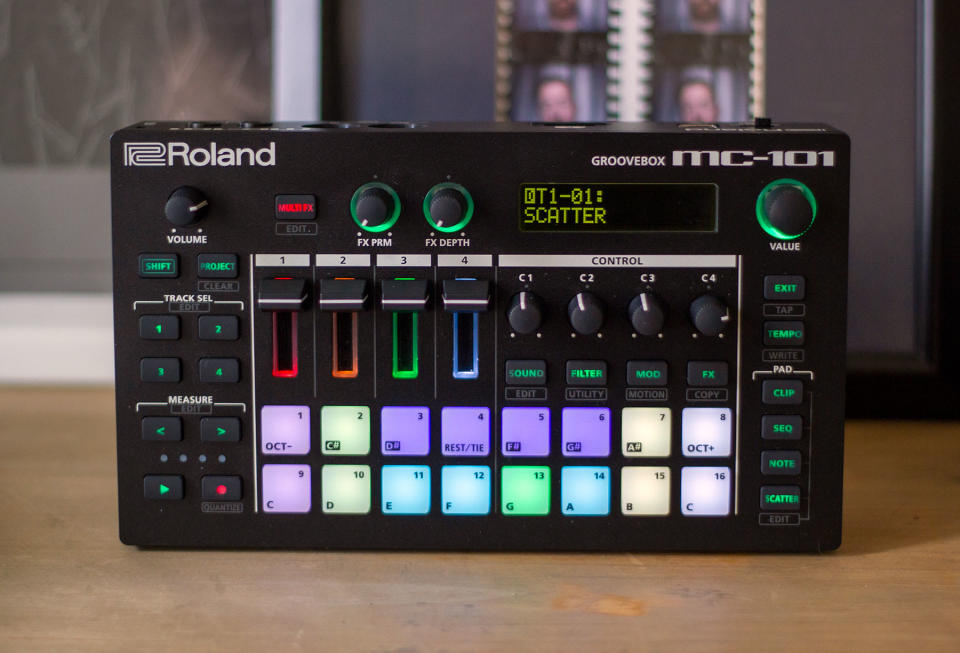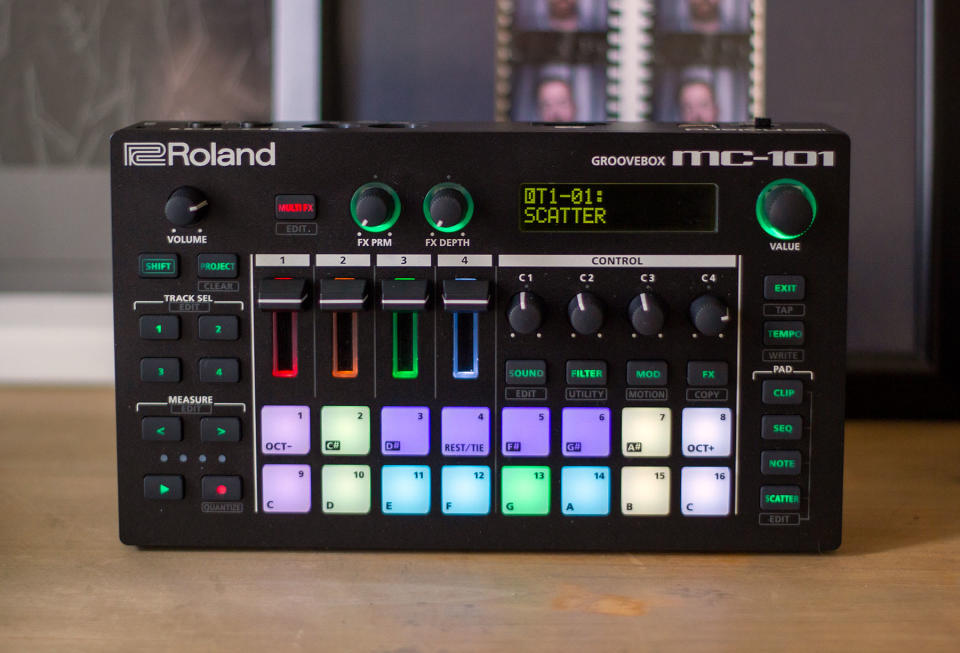Roland MC-101 review: Beats, bass and batteries
Roland's mini groovebox punches well above its weight.
If you think Roland's nostalgia-infused music gear is a new thing, think again. As far back as the mid-'90s (and maybe beyond), the company was cashing in on the gravitas of some of its legendary instruments. In 1996, the company introduced the MC-303 groovebox. It might have had "303" in the name, but the similarities with the iconic TB-303 pretty much stopped at the color scheme. The real news with the MC-303 was the birth of the beloved groovebox series -- all-in-one music-production machines.
The latest in that line is the MC-101, and it's small, somewhat affordable ($500) and surprisingly powerful -- and a welcome addition to the oft-forgotten family. Notably, it doesn't trade in nostalgia (at least, not in the way the MC-303 did), but it should still appeal to music enthusiasts who love Roland's classic music boxes.
Before we get to what it does and how it sounds, the main selling point here is clear: portability. At just 9 x 5 x 2 inches and a shade more than 700 grams (1lb, 9oz), the MC-101 is easy to bring with you anywhere. Add in the ability to run it on four AA batteries (or USB power) and it's clear that this was meant to move with you. And for those who prefer to stick to the studio, the MC-101 should fit into almost any small patch of free desk space.
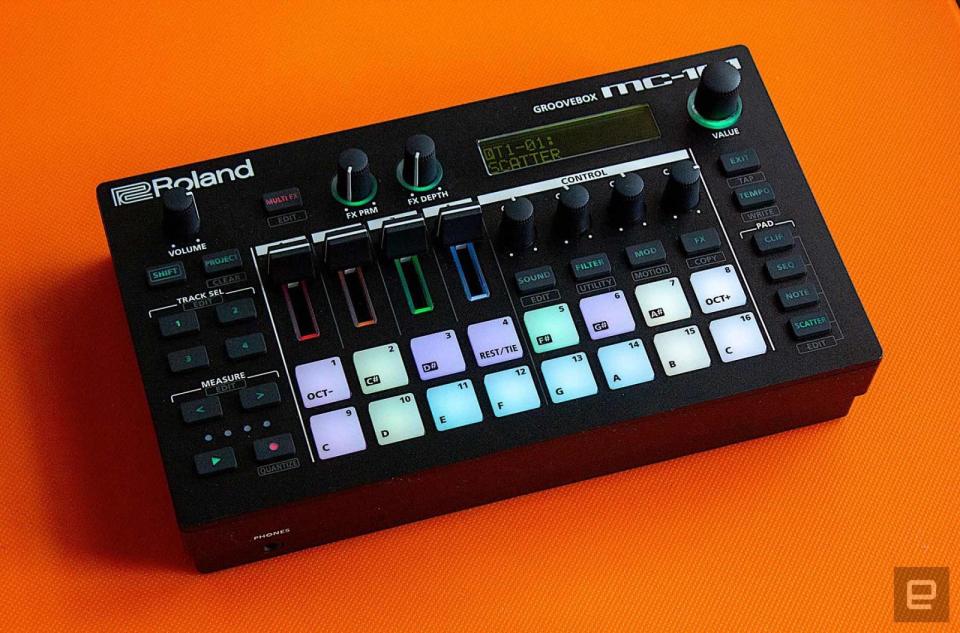
If the MC-101 looks familiar, that's because it has a fairly common groovebox layout. But the MC-101 is particularly similar to the much bigger, pricier Roland MC-707 ($999). For good reason, the two share a lot of DNA: The MC-101 is basically the MC-707 mini.
Whereas the MC-707 is a fully fledged piece of studio gear, the MC-101 omits many of the bells and whistles, leaving you with the essentials for making tracks on the go. This means that around the back, there's not too much going on. There's a power switch, an SD card slot, two five-pin MIDI ports and a pair of ¼-inch outputs (the MC-707 has more output options, including send, return and "assignable"). The 101 also has a 3.5mm headphone jack on the front, unlike the ¼-inch one on the 707.
As for the main interface, there are 16 pads, four-channel faders and four rotary knobs -- no prizes for guessing that the MC-101 offers four tracks to play with. The rest of the controls relate to transport (play, record, et cetera), pad modes (clip, note et cetera) and general utilities -- like headphone volume or the multipurpose Value knob, which you'll be using a lot.
Both the MC-101 and the MC-707 come loaded with more than 3,500 preset sounds. These are organized into logical subcategories such as drums, bass and leads and then more specific sounds like piano, clav and wind (there are many more categories to explore). The range of sounds is comprehensive but skews toward traditional musical instruments rather than unnatural synth sounds. There are some good synth-based presets for sure, but if EDM or dance music is your thing (it is mine), you have to hunt a bit and be willing to experiment (more on this later) for something a little more rave-y.
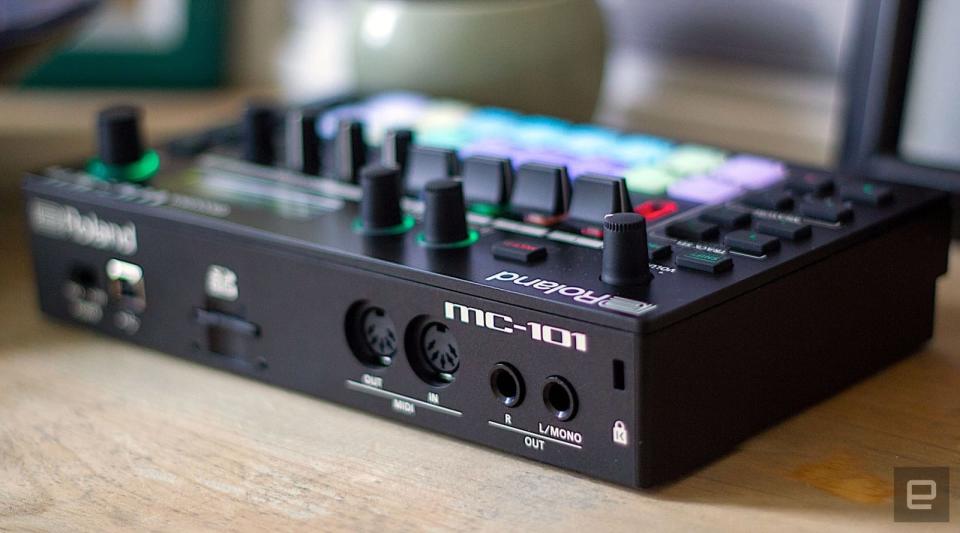
Don't worry though, as you can load a sample of anything you want, which basically blows away any concerns about this thing not having the sound you need. However, that means having access to a library of sounds (either a sample collection or a synth to make your own) and then having to import them. It's not difficult to transfer sounds; mostly it's a case of adding them to a folder on an SD card. But if you like to browse different sounds as you have a melody playing, you need to plan ahead and have suitable samples at the ready.
For drums, there are the usual predefined kits, including classics from the TR-808 and TR-909, along with plenty of alternatives (live/natural drums, jazz kits and so on). I was surprised at the lack of TB-303 lead sounds though. I know it's been overdone and it's kind of hard to capture the wonky magic of the 303 in a sample, but I was hoping there'd at least be some of that squelchy goodness. Instead, there are maybe two or three 303 sounds, and none of them are of the acid-house variety (which is what most people might be hoping for).
As with all grooveboxes, there's a learning curve, and it's moderately steep. The MC-101 isn't difficult to use, but it can feel a little overwhelming at first. The problem with these devices is that they all have their own distinct workflow, so it feels like starting over every time. With practice, I started to realize how Roland wants you to work. Some things are obvious: Pressing Project will open the project menu on the tiny, text-only display. Rotating that Value knob cycles through the options (Load, Write, New, et cetera), and you'll click that rotary to select.
Some things are a little more hidden. There's a prominently placed Shift button on the top left of the MC-101. Anything beyond basic note input is generally accessed with Shift plus... well, almost every knob and button has a second function, and often more. The confusion set in when I was trying to find a setting that I knew I was doing the right key combination for but hadn't realized I was in a different mode (say, Clip mode, rather than Track mode) and it would drive me crazy.
This gets worse when there are other variables in the mix. For example, track one is basically dedicated to drums whereas other tracks can be assigned to Tone (i.e., an instrument) or Looper (better for performances). I spent a few minutes trying to create a Tone track, forgetting I was on track 1. These confusing moments mostly disappear once you have the lay of the land -- although I am still finding more menus and options every day.
Effects, in particular, aren't the most intuitive. If you want to add a little crunch to your kick drums, for example (and, please do!), then you have to press Shift+Sound and then navigate a scroll menu on-screen, click into the effects section and rotate through the available options to find the one you want. Then you have to back out and choose another menu to alter its parameters. Not a huge chore, but it's a few more steps than usual. For what it's worth, the selection of effects, once you do find them, is generous. I started to count but stopped. Roland's website says there are 90, and I'll have to trust it. So whether you're looking for distortion, chorus or delays, you're probably covered.
Sadly, the same can't be said for sound-shaping options. This is one of the main differences between the MC-707 and the MC-101. On the 707, there's a larger, graphical display, and you can dial right down to the individual oscillators. With the 101, you have far fewer controls, although the ones you do have are most of the ones you need (envelopes, cutoff, resonance and so on). I would have loved to have had the option to change wave forms and detune, but there's enough here to keep you going.
Once you have the sounds you want and your tracks set up, sequencing is a pretty standard affair. As with most hardware, you can step sequence or record live, depending on your preference. I kinda suck at "playing" (even with quantize to help) so tend to lean toward step sequencing. These are grooveboxes after all, and step sequencing is perfect for "groove"-based music. Whichever method you prefer, it's easy enough to extend the length of a clip to eight measures. Page (arrow) buttons on the left let you see the notes in play and edit after the fact.
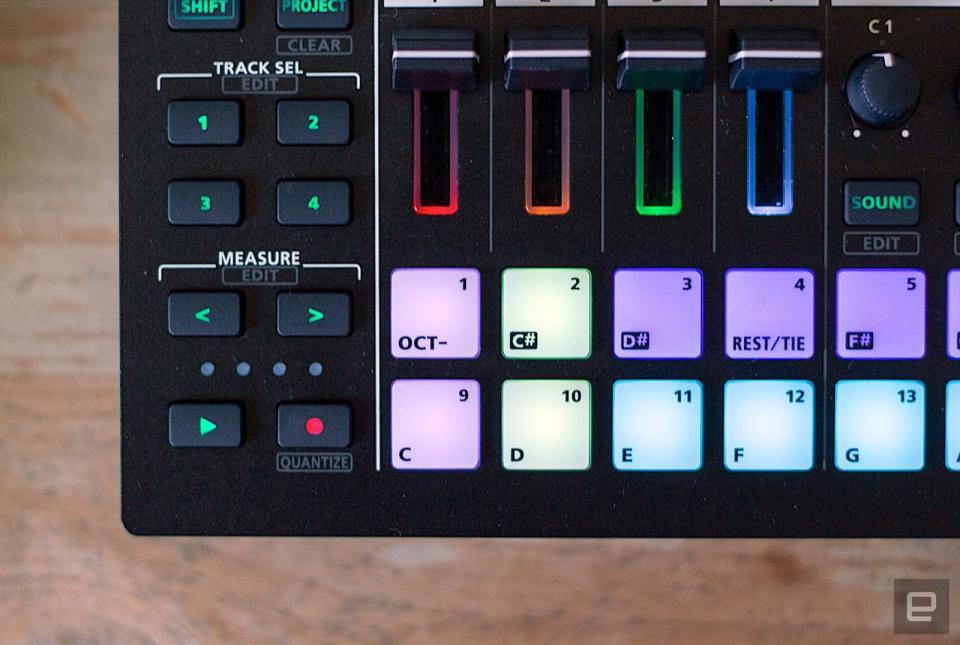
In 2019, having only four tracks to create a song with might seem a little stingy. Some of my DAW productions have four tracks just for different versions of a kick sample. Despite this limitation, the MC-101 has a few tricks up its sleeve. Most obvious is Clip mode. The terminology here makes it difficult to avoid repeating myself, but I'll give it a shot.
Under each of the four tracks, you can build a clip (a phrase, melody or rhythm, depending on what you're doing). You can create new clips on the same track, one per pad, which you can then trigger to play in any order you choose, allowing you to build up a drum beat or melody over time so that your song has progression. If your track is set to Clip mode, you can even change the instrument/sound on a per-clip basis (say you want a sax solo to become a sawtooth lead after eight bars). With this, you can easily make several variations on an idea with different chord progressions, lengths and instruments all within one "track."
The result is that with a little bit of creativity (and button mashing), I can create a song with a number of different components, which I can then order in any way I choose -- or even trigger in a performance, much like Ableton Live's Session view. Throw in the fact that there's a Motion Designer (what appears to be Roland's name for automation) and it's not hard to see how you can go beyond simple loops strung together for a few minutes to something that's dynamic and fluid.
In fact, the more I use the MC-101, the more capable it seems to become. I've always felt that grooveboxes, as fun as they are, were primarily idea machines that you then want to export over to a DAW for fine-tuning and completion. But over the years they've become more adept as complete song-making tools in their own right, and even the plucky little MC-101 has a lot of detailed tools to keep your grooves from feeling, well, boxy.
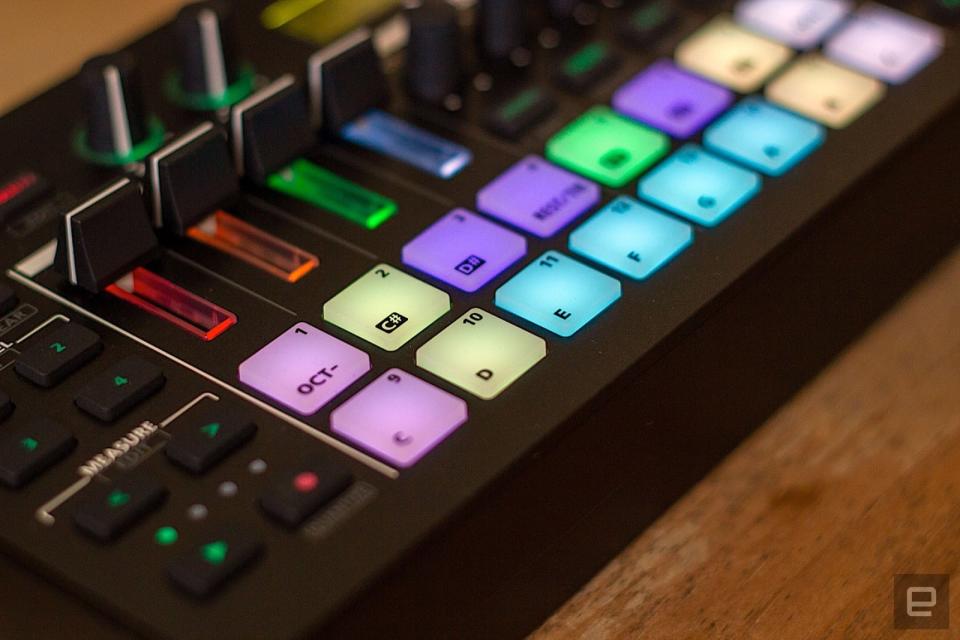
If I had any negatives, it would be some of the more practical stuff. First of all, there's the battery life. The MC-101 ships with four AA batteries, but they only lasted a couple of hours. Roland claims the battery life is around three hours for Alkalines (that's what came in the box) or up to five for Ni-MH cells. If that five-hour claim holds true, it's decent enough, but it's something to be mindful of.
I'd even say that having to use AA batteries is a negative. I generally dislike single-use batteries, as they're wasteful and need recycling. I have good rechargeables, but the life on them is generally worse, so there's a trade-off. I would suggest that a built-in battery might be a better option, but a benefit of AAs is that you can swap them out quickly and be back on your project in no time. That said, you can technically run this off a power brick as long as you have the right USB cable (Type B, not included), but that feels a little clunky. You can, of course, just run it off USB indefinitely if you're at home.
Another slight annoyance is the headphone volume: It's adequate at best. It'll depend on the impedance of your headphones, but chances are, if you're serious about your productions, you have a fairly good (and probably, therefore, high impedance) set. When I switched to a pair of cheap buds, volume improved but at the expense of the sound quality. You can, of course, connect this to an audio interface, but that's less helpful if you're on the move.
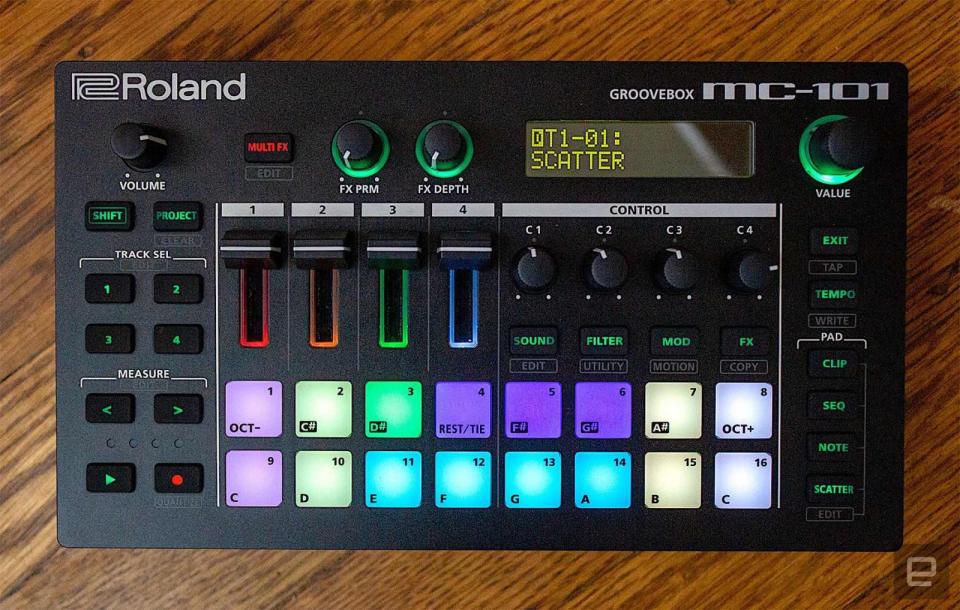
Overall, if you're looking for something portable, versatile and musically capable, Roland's MC-101 is exactly that. While you might get more control over your sounds from Korg's cheaper Volca line, those aren't all-in-one production tools. Teenage Engineering's OP-Z is a worthy rival, depending on your music preference and workflow. It offers more tracks (16) and has some truly novel features, but it's also slightly harder to work with and has a few quirky flourishes that make it more of a specialist device. It's similarly priced to the MC-101 though, so it's definitely worth a look.
For those looking for a good all-round music-making machine that will fit into your studio (and your backpack) and that boasts a library of very usable sounds, can play samples and is big enough to perform with, then the MC-101 might just well be that.
